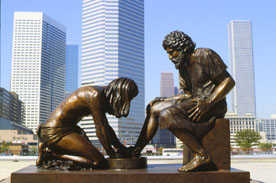
Like some of you, I’ve heard of Bathsheba most of my life. It’s hard not to, having grown up in the church. Her name was mentioned now and again in association with the great King David, but it was always in passing.
When I had the opportunity to meet and spend time with her last summer, I was admittedly lukewarm. And I confess that she was kind of hard to get to know. It took more work to peel back the layers than all of the other ladies I’d gotten to know. She proved less transparent than Rahab, less of a role-model than Deborah, less of a leader than Miriam. My diligence, however, paid off and I was rewarded to find that I connected in so many ways with this woman renown for her beauty:
- as a fellow mother of five;
- as a parent that has known the deep grief of burying a child;
- as a woman desired (thanks to my husband!);
- as a mom with deep desires to see her grown children realize their full potential (and occasionally messes up by meddling in their affairs);
- as someone who looks at herself soberly; and
- as a {repentant} sinner.
It was good to see that I shared these connections with Bathsheba because she is one of those women that are known more for her failures than for her successes. That’s unfortunate, too, because most of my own growth as a follower of God has occurred in the wake of my own {colossal} failures and I sensed the same rang true for Bathsheba as she shared her story with me. As she shared, I was intrigued by her ability not to become mired to her failures because I tend to get stuck in the moments. I obsess about every detail and find it very difficult to crawl out of those moments and move forward.
Bathsheba doesn’t deny that her sin altered the course of her life, or that people were hurt by her choices. They were, and probably none more than her first husband, Uriah. That moment of failure, however, wasn’t wasted. She grew from having endured the hardship of widowhood, guilt and even the death of her son. I think she learned from her mistakes. And God, in seeing that, used her to bless the known world (through her son, King Solomon, in her lifetime), and the entire world (through Jesus Christ, her direct descendant).
Bathsheba is an encouragement to me to live in light of Paul’s words to the New Testament believers in Philippi –
“…forgetting the things that are behind and reaching out for the things that are ahead, with this goal in mind, I strive toward the prize of the upward call of God.” (Phil. 3:13-14 NET)
I invite you to make your own connections with my new friend, Bathsheba, by going here.



